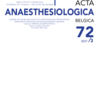The use of methylprednisolone in patients with Coronavirus disease 2019 (COVID-19) requiring intensive care hospitalization: a longitudinal observational study
COVID-19 virus; 6-Methylprednisolone; respiratory distress syndrome; acute respiratory distress.
Published online: Mar 29 2022
Abstract
The use of methylprednisolone in patients with Coronavirus disease 2019 (COVID-19) requiring intensive care hospitalization: a longitudinal observational study.
Background : For a long time, the use of corticosteroids in critically ill patients with coronavirus disease 2019 (COVID-19) has been a controversial treatment. How- ever, given the conflicting evidence on this topic, we studied the effects of methylprednisolone on critically ill patients and - share here our experience on laboratory findings and the Pa02/FiO2 ratio (ratio of partial oxygen concentration on arterial blood gas sample to fraction of inspired oxygen).
Methods : In a population of 68 patients hospitalized in the intensive care unit due because of COVID-19 infection, 28 patients with severe respiratory failure received methylprednisolone on a fixed 12-day regimen (125 mg IV for 2 days, followed by 2x0.5 mg/kg IV twice daily for 5 days, and then a decreasing regimen for 4 days until discontinuation). After day 5 and day 10, we analyzed the levels of CRP (C-reactive protein), lymphocytosis, D-dimer, LDH (lactate dehydrogenase) and PaO 2 /FiO 2 ratio of our patients.
Results : We observed a significant decrease in median CRP levels between day 0 (start of methylprednisolone treatment) and day 5 (p=0.001), and between day 0 and day 10 (p=0.005). No decrease was seen between day 5 and 10 (p=0.352). The same increase in PaO 2 /FiO 2 was recorded between day 0 and day 5 (p=0.009), and between 0 and day 10 (p=0.019). For D-dimer, only a significant difference was found between day 0 and day 10 (p=0.018). No significant difference could be observed for lymphocytosis and LDH levels between the beginning of the treatment and day 5 or day 10.
Conclusion : There is a strong and sustained significant decrease in CRP levels and a tilt in the PaO2/FiO2 ratio after starting methylprednisolone. A slower, but also significant decrease was found for D-dimer. Further research and control group analyses are needed to confirm that this effect is due to corticostreoid treatment. However, this indicates that methylprednisolone may play a very important role in the treatment of the severely ill COVID-19 patients requiring ICU admission.
